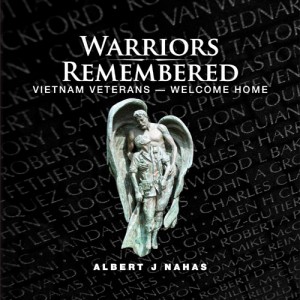Warriors Remembered recently got a mention in the Missoulian. You can read the original article here.
New book honoring veterans features Missoula’s Memorial Rose Garden Park
Even though he has spent the past six years cataloguing and visiting memorials to veterans of the Vietnam War across the United States, Albert Nahas still gets choked up when he talks about the impact of his first visit to Missoula’s Memorial Rose Garden Park.
“I get emotional even talking about this,” said Nahas. “It’s a memorial that I just really feel needed to be publicized. It’s really one of the main inspirations for this whole project.”
On Thursday, Nahas’ work goes public with the release of “Warriors Remembered,” a 240-page, photo-illustrated tome that catalogues and explores the stories of what he considers America’s 100 most interesting, moving and significant memorials to Vietnam veterans.
And right there on the cover is “On Eagles’ Wings,” the 1989 sculpture by Deborah Copenhaver that serves as Montana’s official state memorial to the soldiers who served and those who died in the Vietnam War.
Nahas, a veteran of the Vietnam War himself and a retired Army colonel who now lives in Sugar Land, Texas, said he first became interested in documenting Vietnam memorials in 2002, when he stumbled across a website called VietVet.org, which was devoted to pinpointing the vast array of memorials around the country.
One of the memorials featured on that site was “On Eagles’ Wings.” As it happened, Nahas was planning to come through Missoula on a fishing trip the following summer. He decided to stop by the memorial, and try to find out who was behind its creation.
That’s how he came to meet Missoula resident Charlie Brown, who headed up the committee that created and installed the memorial. Brown and his wife, Sue, hosted Nahas during his visit to Missoula, and introduced him to other members of the committee that put together the memorial.
The more he learned about the history behind the memorial, the more Nahas became inspired.
“I realized that there must be interesting stories behind all of these memorials – most of which were put together through volunteer, grassroots efforts like the one that happened in Missoula,” said Nahas. “So between the VietVets website, and what I learned from Charlie Brown, I just got interested in finding and telling those stories.”
***
Little did he know how big an effort that would turn out to be. When he started the project, Nahas knew of only a few dozen memorials to Vietnam veterans around the country. Today, he pegs that number at more than 1,000. Those range from small plaques at county courthouses, to massive sculptural displays and even a living memorial of 58,000 loblolly pine trees – one for every soldier killed in Vietnam – along a stretch of Interstate 85 in North Carolina.
Nahas said that narrowing his focus down to just 100 of those memorials proved difficult.
“There are stories and people behind every one of those memorials,” said Nahas. “Many of these (memorials), people worked at them 10 years or more; they took a substantial period of time and effort by people who were struggling to make a living at the same time. It really was a sacrifice on the part of these people, so that’s something I really wanted to honor through this book.”
Brown said that in that context, the book’s upfront celebration of Missoula’s memorial is all the more moving.
“It’s great recognition for Montana and for this memorial,” said Brown. “But more importantly, I think this book will bring attention again to the Vietnam generation and the problems they’ve encountered and are still encountering; and veterans in general, because much of what these gentlemen and women are facing in Afghanistan is just as difficult or worse.”
For his part, Nahas said all gratitude should go to the people who inspired the book in the first place.
“I just want to thank and honor the people there in Missoula who took the time and effort to build that memorial,” said Nahas, “because without their effort, there would be no ‘Warriors Remembered.’ ”
“I really feel that any Vietnam vet who’s close to Missoula,” he added, pausing to check his emotions, “needs to stop and see that memorial. It just resonates with anybody who has come too close to death. It’s so, so inspiring.”


